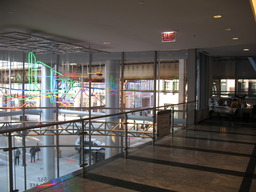
CTA HQ
 CTA HQ |
Most of what I write about in this travelogue focuses on what I'm experiencing wherever I happen to be. But, I often neglect to share how I've arrived, leaving out the details of how I get from one place to the next.
For example, on this current journey I've reached where I am now, Chicago, from Costa Rica in about four months. Over that time I've flown just once. (That was between Austin, Texas and New York City.) Other than that one plane, what all else have I ridden in to get across Central America up to Quebec and finally here to Chicago? I go by:
Bus
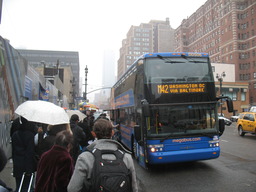 Megabus: New York to DC |
My travels on this recent journey throughout Central America and Mexico were 99% by bus.
Infrastructure connecting the Latin American countries I passed through (Costa Rica, Nicaragua, Honduras, El Salvador, Guatemala, and Mexico) is almost entirely road. I wasn't aware of trains running through any of those countries except Mexico. Even there, the passenger lines that used to run throughout the country have mostly ceased operation and been replaced by bus service. I suppose it could have been possible to make my way across Central America by air as well--but covering such short distances in a plane would have meant seeing far less and cost about 20 times more than taking local buses.
It's not only throughout the developing world that I've found buses to be the most comprehensive, quickest, and cheapest travel option. The Megabus line is my favorite new way to get around both the U.S. and Canada. Tickets are idiotically cheap. It's not too hard to find a $10 fare on the run between Washington, D.C., and New York. I've occasionally paid more than that, sometimes I've gone for less. The buses run on-schedule and all have wi-fi, power outlets, and toilets.
I'm pretty sure established competitor Greyhound is going to die a quick death. Megabus have pretty well sewn up all the major U.S. routes east of the Mississippi. Their reach into Canada doesn't yet extend much farther than the run between Toronto and Montreal, though those lines have already been useful to me. Several of the legs I made getting here were riding cheapo Megabus tickets through Canada, including Montreal to Niagara Falls via Toronto.
Even the final leg of my most recent round-the-world journey, from London to Edinburgh, was an £8 run on Megabus.
Boat
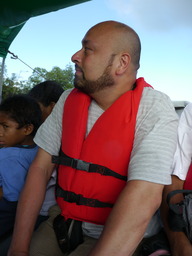 Aboard Panga from Blue- fields to Pearl Lagoon |
The 1% of my recent route through Central America when I didn't travel by bus was covered by panga, a local speedboat.
It would have been possible to go by land to get from the interior of Nicaragua to the Mosquito Coast--there were rough roads connecting the regions. But bus service was so infrequent and the roads so terrible that reaching places such as Bluefields and Pearl Lagoon was far quicker by boat. It was far more fun, too.
Rail
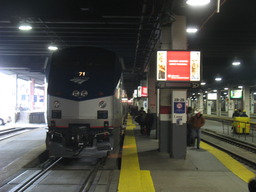 Union Station Chicago |
I used to ride trains only when traveling across other continents: getting around Asia or Europe. But, since returning to the U.S. I've recently come back around to Amtrak. I've been surprised by how booking a ticket just a few days in advance usually makes for a reasonable fare.
Riding the train in this country is usually slower than driving. Runs I've taken recently included one of ten hours between New York and Montreal--a trip that would have been just six-and-a-half hours by car. Another trip of four hours between Seattle and Portland would have taken just two-and-a-half hours by car.
There are times it's worth it to pay a little more for a slower ride on the train. I came here to Chicago on an overnight run from Buffalo which was comfortable and a better place to sleep than a plane or bus would have been. On a train the scenery tends to be a welcome change from the view off familiar interstate highways. It's always nice to get up and walk around. And when the charm of the scenery and ambience aboard the train does fade, most of the runs I've been on recently had wi-fi, too.
Rideshare
When there's absolutely no cheap ticket available on a bus or train I sometimes opt for a ride from somebody offering a lift on-line. I've had mixed luck with the rideshare section of craigslist. Everything seems more organized and efficient through the sites that charge fees. In Germany I found a ride through mitfahrgelegenheit.de, getting between Montreal and Quebec City I've already used amigoexpress.com several times.
Drivers tend to be young adults who could use the gas money: I've been driven between cities by graduate students heading home for the holidays and by musicians on their way to perform a gig. I find it a more sociable way to go than any other means of transport. I engage in conversations with fellow travelers far more often when getting a lift through a rideshare website than any other place out on the road.
Bicycle
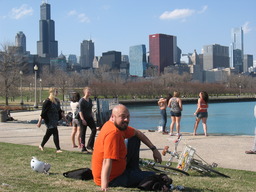 Cycling Break: Chicago |
I haven't taken a long distance bicycle trip in years. There was one time that stands out, once when my brother Alan and I pedaled from Guangzhou to Hong Kong to be on-hand for the handover from British to Chinese sovereignty. But, that date and that cycle ride--are long-past history...
I am always happy whenever a bike is available to get around town. More and more cities, including London, have bike-sharing programs where it's possible to borrow a bike for anywhere from a few minutes to a few hours to get from one part of the city to another. It's even better when a local friend has one to spare. Recent days, Megan and I have been taking advantage of the record-setting warm weather to spin around the lake and just enjoy being outdoors.
On Foot
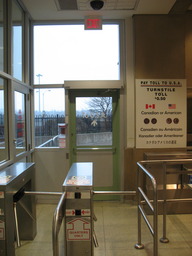 Exit Toll: Niagara Falls |
I don't usually hike long distances from town to town. But, any time when I get out and sight-see within a city (most days I travel) it will always be on foot.
One place that I'm certain to find myself out walking is when crossing a border. Going through immigration and customs formalities at all but one of the borders I've crossed through these last months has involved getting off a bus that went as far as the nearest frontier town, walking on to the border post, through a strip of no-man's land into the country on the other side, and strolling along until finding a local bus or van to carry me along to my next destination.
I saw a twist in this familiar formula of crossing the border on foot a few weeks ago when walking from Canada into the U.S. at Niagara Falls. Along the footpath leading up to the bridge was a turnstile. Above it was a large sign: "PAY TOLL TO U.S." To pass, two quarters, (either USD¢ or CDN¢ accepted) had to be deposited before stepping out onto the pedestrian bridge spanning the two countries. I had never, elsewhere in the world, seen an exit tax for foot traffic to be paid into a turnstile.
I recognized this wasn't a large amount. And though there was no officer in the room asking for the money, this unexpected exit fee to walk across the bridge brought me back to so many unpleasant times crossing other borders when I've been hit up for some "tax" or unofficial fee (i.e., sleazy bribe) to exit or enter some country. My immediate thought was, "A 'border tax?' I'm not going to pay this," quickly followed with the strategic thought of backcocking the turnstile one half turn to then slip through the space between the arms (a la sneaking onto a subway platform.) Nobody else--border guard or fellow pedestrian--was around to see whether I did.
After thinking about it, I decided even if dropping a couple coins to get out of a country was a lame and new concept to me, it was clearly a legitimate fee that didn't amount to much. I paid the toll and walked across to the U.S..
I just hope toll turnstiles don't become a common feature at all border crossings.
Subway and City Bus
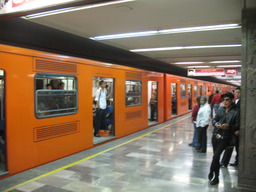 Mexico City Subway Platform |
As with getting around by bicycle or on foot, by their nature, I tend to ride subways and municipal buses to get around within cities rather than to cover ground from one town to the next. Sometimes it does work out to take local transit across distances. The best option after visiting Niagara Falls to get all the way into Buffalo was a local city bus.
Google have a good part of their site devoted to plotting out itineraries on various transit systems, so it's possible to suss it out ahead of time. But, another development of technology, RFID transit cards, has actually made it more complex (or at least costly) for casual travelers passing through town such as myself when taking public transportation.
Systems in so many cities now use some sort of stored-value card to deduct fares when riding buses or trains. Most transit agencies do still accept cash at the farebox--but without offering the connecting transfer along to the next bus or train that a stored-value card would allow.
Another nuisance: each of these RFID cards is unique to its particular city. I usually pick one up if I know I'll be staying on in any one town for more than a couple days. There's usually a nominal charge of around $5 USD. I now have stacks of these held in several calling-card cases for use in a dozen cities around the globe. They have actually come in handy on return visits to cities with extensive metro systems I've often passed through recently, namely Washington, D.C., Chicago, and London.
But, I doubt I'll ever use that one I picked up in Isfahan again. I hope that some day there is a call to use the one I held onto from Urumqi. Souvenirs all in the end, perhaps.
Airplane
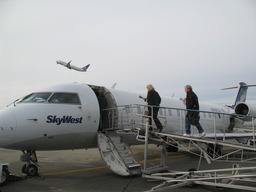 Flight to Zach's Wedding |
Though it's not always a hard-and-fast rule I generally avoid flying. In-part, that's because it's usually the most expensive ticket from point to point. In-part that's because it's usually the least interesting way to get from point to point. On certain trips I will even restrict myself from going by plane at-all, just to make the overall experience more rewarding. I have made several journeys over the duration of which I decided I would not take a single flight until after I'd crossed from east Asia far into western Europe. I began the most recent of those overland trips in summer of 2007 and autumn of 2010.
When necessary, I fly. I'm thankful that times have changed in ways that are good for my style of travel when it comes to buying air tickets. Most airlines now charge roughly half the cost of a round-trip ticket for a one-way flight. One-way flights used to run two-thirds to three-quarters the round-trip rate for no clear reason.
I'm generally flexible enough with travel dates that I can usually book a cheap fare if I look a few weeks in advance. There are lots of sites good at comparing the fare for any conceivable itinerary. I've been partial to kayak.com for the last few years, though they don't cull their data from all airlines, (e.g., Southwest.) But, they certainly have found low fares on carriers I wouldn't have known about. The last flights I've taken have been on airlines I'd never heard of (Frontier and Spirit).
I'll be in transit-mode soon. My time here in Chicago will be up in a couple days. I'm about to take to the air again...
Next Stop: A surprise